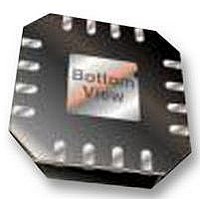ADP322ACPZ-135 Analog Devices Inc, ADP322ACPZ-135 Datasheet - Page 18

ADP322ACPZ-135
Manufacturer Part Number
ADP322ACPZ-135
Description
IC, LDO, TRIPLE, 0.2A, 16LFCSP
Manufacturer
Analog Devices Inc
Datasheet
1.ADP322ACPZ-175-R7.pdf
(24 pages)
Specifications of ADP322ACPZ-135
Primary Input Voltage
3.8V
Output Voltage
3.3V
Dropout Voltage Vdo
110mV
No. Of Pins
16
Output Current
200mA
Voltage Regulator Case Style
LFCSP
Operating Temperature Range
-40°C To +125°C
Output Voltage Fixed
3.3V
Rohs Compliant
Yes
Lead Free Status / RoHS Status
Lead free / RoHS Compliant
Available stocks
Company
Part Number
Manufacturer
Quantity
Price
Part Number:
ADP322ACPZ-135-R7
Manufacturer:
ADI/亚德诺
Quantity:
20 000
ADP322/ADP323
CURRENT-LIMIT AND THERMAL OVERLOAD
PROTECTION
The ADP322/ADP323 are protected against damage due to
excessive power dissipation by current and thermal overload
protection circuits. The ADP322/ADP323 are designed to
current limit when the output load reaches 300 mA (typical).
When the output load exceeds 300 mA, the output voltage is
reduced to maintain a constant current limit.
Thermal overload protection is built in, which limits the
junction temperature to a maximum of 155°C (typical). Under
extreme conditions (that is, high ambient temperature and
power dissipation) when the junction temperature starts to
rise above 155°C, the output is turned off, reducing the output
current to zero. When the junction temperature drops below
140°C, the output is turned on again and the output current
is restored to its nominal value.
Consider the case where a hard short from VOUTx to GND
occurs. At first, the ADP322/ADP323 limits current so that only
300 mA is conducted into the short. If self-heating of the junction
is great enough to cause its temperature to rise above 155°C,
thermal shutdown activates, turning off the output and
reducing the output current to zero. As the junction tempera-
ture cools and drops below 140°C, the output turns on and
conducts 300 mA into the short, again causing the junction
temperature to rise above 155°C. This thermal oscillation
between 140°C and 155°C causes a current oscillation between
0 mA and 300 mA that continues as long as the short remains
at the output.
Current and thermal limit protections are intended to protect
the device against accidental overload conditions. For reliable
operation, device power dissipation must be externally limited
so that junction temperatures do not exceed 125°C.
THERMAL CONSIDERATIONS
In most applications, the ADP322/ADP323 do not dissipate a
lot of heat due to high efficiency. However, in applications with
a high ambient temperature and high supply voltage to output
voltage differential, the heat dissipated in the package is large
enough that it can cause the junction temperature of the die to
exceed the maximum junction temperature of 125°C.
When the junction temperature exceeds 155°C, the converter
enters thermal shutdown. It recovers only after the junction
temperature decreases below 140°C to prevent any permanent
damage. Therefore, thermal analysis for the chosen application
is very important to guarantee reliable performance over all
conditions. The junction temperature of the die is the sum of
the ambient temperature of the environment and the tempera-
ture rise of the package due to the power dissipation, as shown
in Equation 2.
Rev. 0 | Page 18 of 24
To guarantee reliable operation, the junction temperature of
the ADP322/ADP323 must not exceed 125°C. To ensure that
the junction temperature stays below this maximum value, the
user must be aware of the parameters that contribute to junction
temperature changes. These parameters include ambient tem-
perature, power dissipation in the power device, and thermal
resistances between the junction and ambient air (θ
number is dependent on the package assembly compounds used
and the amount of copper to which the GND pins of the package
are soldered on the PCB. Table 7 shows typical θ
ADP322/ADP323 for various PCB copper sizes.
Table 7. Typical θ
Copper Size (mm
JEDEC
100
500
1000
1
The junction temperature of the ADP322/ADP323 can be
calculated from the following equation:
where:
T
P
where:
I
I
V
Power dissipation due to ground current is quite small and
can be ignored. Therefore, the junction temperature equation
simplifies to
As shown in Equation 4, for a given ambient temperature,
input-to-output voltage differential, and continuous load
current, there exists a minimum copper size requirement
for the PCB to ensure that the junction temperature does not
rise above 125°C. Figure 50 to Figure 53 show junction
temperature calculations for different ambient temperatures,
total power dissipation, and areas of PCB copper.
In cases where the board temperature is known, the thermal
characterization parameter, Ψ
junction temperature rise. T
the formula
The typical Ψ
25.2°C/W.
LOAD
GND
Device soldered to JEDEC standard board.
D
A
IN
is the power dissipation in the die, given by
is the ambient temperature.
and V
is the ground current.
T
P
T
T
is the load current.
D
1
J
J
J
= T
= T
= T
= Σ[(V
OUT
A
A
B
+ (P
+ (P
+ {Σ[(V
are input and output voltages, respectively.
JB
IN
value for the 16-lead, 3 mm × 3 mm LFCSP is
D
D
− V
2
× Ψ
× θ
JA
)
IN
OUT
Values
JA
JB
− V
)
)
) × I
OUT
ADP322/ADP323 Triple LDO (°C/W)
49.5
83.7
68.5
64.7
LOAD
J
) × I
is calculated from T
JB
, can be used to estimate the
] + Σ(V
LOAD
] × θ
IN
× I
JA
}
GND
)
JA
values for the
B
JA
and P
). The θ
D
using
JA
(2)
(3)
(4)
(5)














